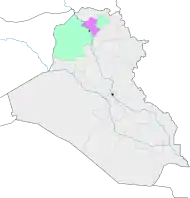Batnaya
Batnaya (Arabic: باطنايا, Syriac: ܒܛܢܝܐ)[2] is a town in northern Iraq, located 14 miles north of Mosul and about 3 miles north of Tel Keppe.[2] The town had a population of about 5,000, but most fled during the Northern Iraq offensive by ISIS in 2014. As of 2018, half of its locals live in a camp near Tesqopa.[3] The town was captured by Kurdish Peshmerga on 20 October 2016 during the Mosul liberation.[4]
Batnaya | |
|---|---|
 Batnaya | |
| Coordinates: 36°32′15″N 43°7′24″E | |
| Country | |
| Governorate | Nineveh |
| District | Tel Kaif |
| Population | |
| • Total | 800 |
| Time zone | GMT +3 |
In early 2019, the United Nations planned to rehabilitate hundreds of damaged homes in the town. In June the first thirty home were restored and residents started returning home.[5]
Early history
Batnaya is first mentioned in the 7th century under the name Beth Madai.[6] The first manuscript found from the town, in the 15th century, was by a priest whose family was from Hakkari.[7]
Batnaya was attacked by the army of Nader Shah in 1743, who destroyed the village extensively and is believed to have killed half of its inhabitants. [8] In the past Batnaya used to be famous for making matting from the reeds its people used to cultivate in the valley of al-Khoser river. Currently, some of its inhabitants are cultivating different kinds of crops while others are involved in non-agricultural trades.
In 1944 the Mar Qeryaqos Church was built on the ruins of a monastery by the same name believed to have been built in the early 15th century. A second but smaller church, Mart Maryam, was built in 1966, while the church of Mar Gewargis was mentioned in an inscription dated 1745.
In Batnaya are several inscriptions. One dating to 1545 by Darweesh bin Yohanan from the village of Aqreen is entitled "Prayers for the Dead". Another is a complete bible inscribed in Chaldaya by the priest Ataya bin Faraj bin Marqos of Alqosh, dating to 1586.
As with all the other currently Assyrian villages that belong to the Chaldean Catholic Church, Batnaya's Assyrian Catholic population used to follow the Church of the East until the seventeenth to eighteenth century, when the efforts of the Catholic Church came to fruition and the Church of the East was divided.[9]
References
- Briggs, Billy. "Iraq war: The destruction and liberation of Batnaya". The Ferret.
- "باطنايا" (in Arabic). Ishtar TV. Retrieved 8 November 2020.
- "80-year-old dreams of the day her village will recover from ISIS war". Rûdaw. 30 November 2018. Retrieved 8 November 2020.
- Briggs, Billy (13 April 2017). "The destruction and liberation of Batnaya". The Ferret. Retrieved 8 November 2020.
- "Restored houses bring families back home to Batnaya". UNDP. Retrieved 2019-07-17.
- Wilmhurst, David (2000). The Ecclesiastical Organization of the Church of the East, 1318-1913. p. 232.
- Wilmhurst, David (2000). The Ecclesiastical Organization of the Church of the East, 1318-1913. p. 232.
- Wilmhurst, David (2000). The Ecclesiastical Organization of the Church of the East, 1318-1913. p. 234.
- Wilmhurst, David (2000). The Ecclesiastical Organization of the Church of the East, 1318-1913. p. 234.
